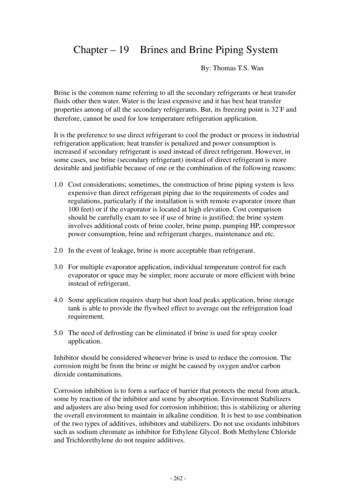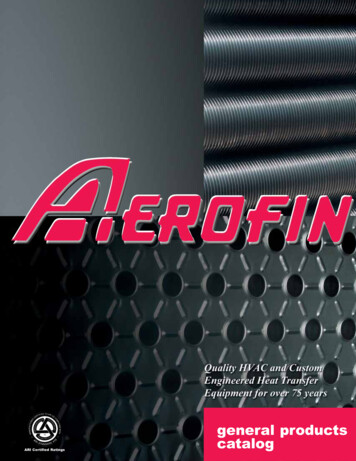
Transcription
Chapter – 19Brines and Brine Piping SystemBy: Thomas T.S. WanBrine is the common name referring to all the secondary refrigerants or heat transferfluids other then water. Water is the least expensive and it has best heat transferproperties among of all the secondary refrigerants. But, its freezing point is 32 F andtherefore, cannot be used for low temperature refrigeration application.It is the preference to use direct refrigerant to cool the product or process in industrialrefrigeration application; heat transfer is penalized and power consumption isincreased if secondary refrigerant is used instead of direct refrigerant. However, insome cases, use brine (secondary refrigerant) instead of direct refrigerant is moredesirable and justifiable because of one or the combination of the following reasons:1.0 Cost considerations; sometimes, the construction of brine piping system is lessexpensive than direct refrigerant piping due to the requirements of codes andregulations, particularly if the installation is with remote evaporator (more than100 feet) or if the evaporator is located at high elevation. Cost comparisonshould be carefully exam to see if use of brine is justified; the brine systeminvolves additional costs of brine cooler, brine pump, pumping HP, compressorpower consumption, brine and refrigerant charges, maintenance and etc.2.0 In the event of leakage, brine is more acceptable than refrigerant.3.0 For multiple evaporator application, individual temperature control for eachevaporator or space may be simpler, more accurate or more efficient with brineinstead of refrigerant.4.0 Some application requires sharp but short load peaks application, brine storagetank is able to provide the flywheel effect to average out the refrigeration loadrequirement.5.0 The need of defrosting can be eliminated if brine is used for spray coolerapplication.Inhibitor should be considered whenever brine is used to reduce the corrosion. Thecorrosion might be from the brine or might be caused by oxygen and/or carbondioxide contaminations.Corrosion inhibition is to form a surface of barrier that protects the metal from attack,some by reaction of the inhibitor and some by absorption. Environment Stabilizersand adjusters are also being used for corrosion inhibition; this is stabilizing or alteringthe overall environment to maintain in alkaline condition. It is best to use combinationof the two types of additives, inhibitors and stabilizers. Do not use oxidants inhibitorssuch as sodium chromate as inhibitor for Ethylene Glycol. Both Methylene Chlorideand Trichlorethylene do not require additives.- 262 -
Figure 19-1 lists the common brines and the practical working brine temperature forthe brine. The figure also shows the recommended tube material for the heatexchanger. The temperature limits shown are the approximate brine leavingtemperature limit for flooded shell-and-tube heat exchanger. The temperaturelimitation is that heat exchanger selection would become unpractical and unviable ifthe leaving brine temperature is lower the temperature indicated. However, if the heatexchanger is DX, the leaving brine temperature limit for propylene glycol can beextended down to -25 and ethylene glycol down to -30 respectively at the properbrine concentration.There are basically five groups of common brines:(A) Salt brines such as calcium chloride and sodium chloride.(B) Glycol brines such as propylene glycol and ethylene glycol.(C) Alcohol brines such as methanol and ethanol.(D) Chlorinated Hydrocarbon brines such as Methylene Chloride andTrichlorethylene.(E) Floriated hydrocarbon brine such as R-11.Sodium chloride and calcium chloride brine were very popular because low cost. Dueto the corrosive nature of the brine, maintenance and initial cost are to be balancedand justified if sodium chloride or calcium chloride is to be selected. Other commonlyused brines for refrigeration application are propylene glycol, ethylene glycol andmethanol. Propylene glycol is the preferred brine for food, beverage and daily productapplication.Ethylene Glycol is none corrosive brine. But, it becomes an acid end product when itis oxidized by air. Therefore, an inhibitor should be used for Ethylene Glycol brine. Aready mixed and specially engineered heat transfer fluids of propylene glycol andethylene glycol are available in the market from suppliers such as Dow Chemical.Ethanol and methanol are the derivative from alcohol and it is a flammable liquid.Ethanol is more expensive than methanol and the heat transfer properties are not asgood as methanol brine. Therefore, methanol is better choice over ethanol.Trichlorethylene and Methyl Chloride are halocarbons. It is only used as secondaryrefrigerant for very special low temperature application that well below -40 .R-11 is a very good secondary refrigerant; it can be used for very low temperaturebrine application down to -150 . The only problem is that it is restricted due to CFCO-zone problem.The safety and toxicity concerns for various common secondary refrigerants are listedas the following:- 263 -
- 264 -
Table 19-01 Brine Safety RatingsBrineSodium ChlorideCalcium ChloridePropylene GlycolSafety RatingNon-flammableNon-flammableFlammable, moderate fire hazard. Flash point 210 to 225 undiluted.Ethylene GlycolFlammable, moderate fire hazard. Flash point 232 to 240 undiluted.Methanol waterFlammable, fire hazard. Flash point 54 to 60 undiluted. Flash point 75 30% solution.EthanolFlammable, fire hazard. Flash point 55 undiluted.TrichloroethyleneNon-flammable at ordinary ambientMethylene Chloride Non-flammable at ordinary ambientR-11Non-flammableTable 19-02 Brine Toxicity DataBrineSodium ChlorideCalcium ChloridePropylene GlycolEthylene GlycolMethanol waterEthanolTrichloroethyleneMethylene ChlorideR-11Safety RatingNon-toxic. Suitable for direct contact with foodNon-toxic.Non-toxic. Suitable for food processingToxic.Toxic.Non-toxicToxic. Threshold limit is about 100 ppmSlight toxicity, but generally considered Non-toxic,but threshold limit is about 500 ppmNon-toxic, but threshold limit is about 1000 ppmThe data and the transportation properties of the brine required for heat transfercalculation or heat exchanger selection are as the following:(1)(2)(3)(4)(5)(6)Brine solution concentration, percent by weight.Brine inlet temperature and outlet temperature.Specific heat.Specific gravity.Viscosity.Thermal conductivity.The transportation properties for the three typical brines of propylene glycol, ethyleneglycol and methanol are shown in the figures from 19-2 to 19-16:For Propylene Glycol Brine:- 265 -
Figure 19-2Figure 19-3Figure 19-4Figure 19-5Figure 19-6Propylene Glycol – Freeze Point.Propylene Glycol – Specific Gravity.Propylene Glycol – Thermal Conductivity.Propylene Glycol – Specific Heat.Propylene Glycol – Viscosity.For Ethylene Glycol Brine:Figure 19-7 Ethylene Glycol – Freeze Point.Figure 19-8 Ehylenen Glycol – Specific Gravity.Figure 19-9 Ethylene Glycol – Thermal Conductivity.Figure 19-10 Ethylene Glycol – Specific Heat.Figure 19-11 Ethylene Glycol – Viscosity.For Methanol Brine:Figure 19-12 Methanol – Freeze Point.Figure 19-13 Methanol – Specific Gravity.Figure 19-14 Methanol – Thermal Conductivity.Figure 19-15 Methanol – Specific Heat.Figure 19-16 Methanol – Viscosity.Most heat exchanger selection software programs include the transportation propertiesof the commonly used brine. Refer to brine software program for more accurate brinedata and all other brines.Sometime, the refrigeration system is required to be designed to cool the process fluid.The process fluid is not common brine and therefore, the specific heat, specificgravity, thermal conductivity and viscosity information are to be furnished by the userin order to make heat exchanger selection.Brine concentration is usually expressed by percent by weight, not percent by volume.Percent by Weight and Percent by Volume conversion curve is shown in the Figure19-2 for propylene glycol, Figure 19-7 for ethylene glycol and Figure 19-12 formethanol.The viscosity of a brine effects heat transfer greatly. The viscosity is higher when thebrine temperature is lower. Also, the viscosity is higher when the brine concentrationis higher except the ethanol and methanol (see viscosity curve in Figure 19-16 formethanol. Ethanol has similar characteristic as methanol).In heat exchanger selection and heat transfer calculation, the Reynolds number is avery important indicator if the heat exchanger for brine cooling is viable.REYNOLDS NUMBER (Re):Re M x TUBE ID----------------------μ x 2.42- 266 -
- 267 -
- 268 -
- 269 -
- 270 -
- 271 -
- 272 -
- 273 -
- 274 -
- 275 -
- 276 -
- 277 -
- 278 -
- 279 -
MRe GPM x S.G. x 500 x ----NO.TUBES x TUBE FLOW AREAV x 92,880 x S.G. x TUBE :GPMS.G.NO.PASSNO.TUBESTUBE AREAIDVTUBE IDμ Gallons per minute brine flow Specific gravity of the brine Pass arrangement of the heat exchanger Number of tubes in the heat exchanger. Squire feet area of tube surface. Tube ID, Feet Brine velocity, ft/sec. Inside diameter of the tube, Ft. Viscosity, CentipoiceFrom the above formula, it is obvious that the viscosity of the fluid is the mostimportant factor to determine the Reynolds number; the Reynolds number is larger ifthe viscosity is lower. For a viable heat exchanger selection, the Re value must begreater than 2,100 for turbulent flow. If the Re number is below 2,100, it representsthe laminar flow and the heat exchanger selection is not viable.Viscosity will greatly impact on the size of the heat exchanger. Higher viscosity of thebrine requires bigger heat exchanger and larger heat transfer surface. From experience,in case of R-22 application, the general guide for the tube external surfacerequirements is as the following:For R-22Viscosity-------------------23512Sq.Ft./TR Tube Surface---------------------------------to 3 CPto 5 CPto 8 CPCP8 Sq.Ft./TR10 Sq.Ft./TR14 Sq.Ft./TR18 Sq.Ft./TRBrine Flow Calculation:Brine flow is determined by:- 280 -
(1) Heat Load.(2) Brine Transportation Properties:Specific GravitySpecific Heat(3) Brine Temperature Difference or RangeFormula for Brine Flow & Refrigeration Capacity:GPM x S.G. x Cp x T-------------------------------------24TR Btu/Min GPM x 8.33 x S.G. x Cp x T 499.8 x GPM x S.G. x Cp x TBtu/HrTRGPMS.G.Cp T Tons of RefrigerationFluid Flow Rate, Gallons per MinuteSpecific Gravity of the FluidSpecific Heat of the Fluid, BTU/LB- FTemperature Range of the Fluid, F, (T2 – T1)OrGPM TR x 24-------------------------------S.G. x Cp x TGPM Btu/Min---------------------------------8.33 x S.G. x Cp x TGPM Btu/Hr------------------------------------499.8 x S.G. x Cp x TExample for Brine Flow Calculation:Capacity:Brine range:Fluid:220 TR27.5 F to 21 F35% By weight ethylene glycol brine- 281 -
27.5 21----------------- 2Brine average temperature 24.3 FBrine properties at the mean temperature of 24.3 F:Specific Gravity:Specific Heat:GPM x S.G. x Cp x T-------------------------------------24TR 2201.0560.845 BTU/LB- FGPM x 1.056 x 0.845 x (27.5 - --24 Brine Flow 910 GPMFormula for Brine Pumping HP:BHP WxH-----------------------------------33,000 x EFFICIENCYBHPWH Brake HP. Weight of liquid. Lbs/Min. Total head in feet (Corrected for brine flow)Heat Exchanger Tube Materialfor Common Refrigerantsand Secondary RefrigerantsSodium ChloridePropylene GlycolEthylene GlycolCalcium ChlorideMethanolTrichlorethyleneMethyl ChlorideSodium NitrateCalcium u. NiCopperCu. Ni.CopperCopperS.S.- 282 opperCopperCopperCopper*CopperCopper
WaterSea WaterHalocarbonsHydrocarbonsAmmoniaCopperCopperCu. Ni.CopperCopperSteelNotes:*Must be inhibited.Ethylene Glycol and Sodium Chloride brine are also recommended tobe inhibited.Brine Concentration Determination:In general speaking, the brine concentration should be optimized that the freezingpoint of the brine should be more than 5 below the lowest possible evaporativetemperature for the refrigeration system. For example: In the case of ethylene glycolbrine system, the lowest evaporative temperature is 14 , the freezing temperature ofthe brine should be at least 14 - 5 9 , therefore, the concentration of theethylene glycol brine should be 24% by weight. General speaking, too much ofconservative by increase the percent of brine concentration has no advantage to theoperation and it is harmful to energy consumption, because the heat transfer ispenalized and the power consumption is increased due to higher viscosity.Brine Piping:The brine piping system construction shall generally follow the water piping systempractices.Figure 19-17 is the equivalent length of valves and fittings for the carbon steel pipingin addition to the regular piping run. Figure 19-18 is the pressure drop through pipefor water flow.Figure 19-19 is the pressure drop correction factor for brine flow. The flow must beturbulent flow; that is the Turbulent Flow Factor (β) must be greater 0.1.- 283 -
- 284 -
- 285 -
- 286 -
β DxVxS----------------- 0.1μWhere:β Turbulent FactorDVS Diameter of the pipe, inches. Velocity brine flow, Ft/Sec. Specific gravity.μ Absolute viscosity, centipoises.- 287 -
Figure 19-14 Methanol – Thermal Conductivity. Figure 19-15 Methanol – Specific Heat. Figure 19-16 Methanol – Viscosity. Most heat exchanger selection software programs include the transportation properties of the commonly used brine. Refer to brine software program for more a










